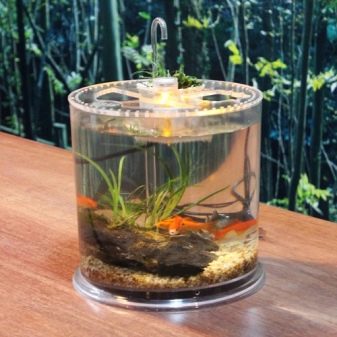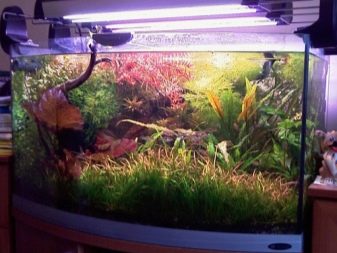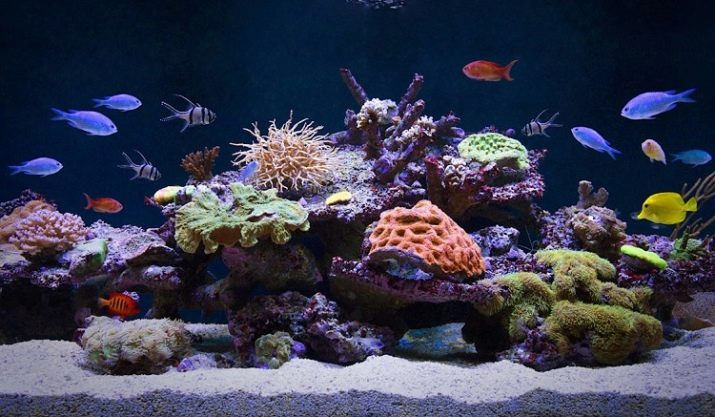Everything for the aquarium: from equipment to decor

We decided to get an aquarium - a great idea, but not suitable for impromptu. You will have to spend time on this, because, in addition to the aquarium itself and the living creatures in it, you need to pick up equipment, soil, decorations and vegetation for it. And this requires not only time and money, but also certain competencies.

Choosing an aquarium
The first thing that is bought is the container itself for the future home underwater kingdom. And only then, based on its characteristics, all the content and operational support will be purchased. The material from which the aquarium is made is either glass or acrylic. Many buyers do not even suspect that aquariums are not only glass.
What are the advantages of an acrylic tank:
- cheaper than glass construction;
- lighter in weight than glass;
- more durable, you will be insured against leaking seams;
- a variety of more interesting shapes than glass models.


But acrylic aquariums have a serious drawback - they scratch quite easily. If there are grains of sand left on the cloth with which you wipe the container, this is already a serious risk of scratching. In addition, if acrylic is cheap, it will turn yellow noticeably over time. It is necessary to clean an acrylic aquarium using special means, since it is impossible to correct the situation with standard household chemicals (it will become cloudy from it).
Important! Glass aquariums are bought less and less today - in many positions they are inferior to acrylic.


As for the size of the container, if you are a beginner aquarist, choose models that are deep and wide. Despite their impressive size, they are easier to care for.The minimum volume is 60 liters, the optimal one is 100 liters. Aquariums can be very different in shape, but rectangular and panoramic are the most in demand.
The main thing is that the tank fits into the interior of the room where it will stand.

Drawers and racks
At this point, a lot of mistakes happen. What the aquarium will stand on is very important. You can put it somewhere else, bypassing the cabinet, but this is the preferred and reliable option.
Requirements for choosing a curbstone:
- must be made of moisture resistant material;
- must be strong and reliable in relation to the weight of the aquarium;
- it is good if the cabinet is on height-adjustable legs.
If in doubt, you can take a metal pedestal that will definitely not deform under the weight of a mini-reservoir. But such a design also costs a lot.



Necessary equipment
Sprinkling sand, shell stones, pouring water and letting the fish in - this is how many neophytes imagine all the worries associated with the appearance of an aquarium in the house. Of course, everything is not so primitive. Each step requires an understanding of its role in the process of creating a reservoir in which its inhabitants will be comfortable.
It is impossible to imagine aquarium equipment without heater. It can be bottom - it is fixed directly in the ground, which has a good effect on the condition of the aquarium flora. There is an external flow heater - it will be placed outside the container with a cut in the filter hose. This heats the water well and evenly. And there is also an immersion heater, which must be lowered into the liquid up to a certain mark.


When purchasing a heater, ask about its power indicators, as well as how the thermostat works in the device. And this is really important: if the thermostat breaks down, all the inhabitants of the underwater kingdom will simply boil in incredibly hot water. The benchmark in the power of the equipment is 1 W per 1 liter of the volume of the container.
It will also require an aquarium compressor - it supplies air, organizing aeration of the water. And here, be sure to pay attention to the power of the device, its noiselessness and the ability to regulate the air flow. By multiplying the volume of the tank by a factor of 0.5, you will find out how powerful the compressor should be for your aquarium.
Maintains cleanliness and order in the container filter... It can be external and internal, bottom and canister. The bottom model is placed under the ground, preventing soil acidification. But for a home reservoir, it is difficult to operate. But the external filter is quite a comfortable design, installed outside the aquarium. The most inexpensive option would be an internal filter, but it has a drawback - its size. You will often have to put filter media in it.


Lighting
The choice of lighting lamps depends on how living organisms will develop in the aquarium, how they will reproduce and grow. Incandescent bulbs are not considered a suitable option for an aquarium - they are more suitable for terrariums. And although some people are in a hurry to buy incandescent lamps, this is not the most rational choice: they have too much heat transfer for a mini-reservoir, and they are also capable of provoking algal outbreaks.
But fluorescent lamps are suitable, since:
- there is little heat from them, but just as much as the underwater kingdom needs;
- they boast a wide range of spectral radiation, which is significant for an aquarium;
- they have actinic light, which is beneficial for underwater inhabitants;
- they cover a large area compared to an incandescent lamp;
- among them you can find models with high luminous efficiency.


Beginners are usually advised to purchase T5 lamps., which have a relatively high luminous efficiency and light point emission. There are also metal halide lamps that can arrange a celebration of light in an aquarium - the effect of the sun playing in shallow water is observed. But these lamps give off too much heat.
To avoid overheating the liquid, you will have to enlist cooling fans or just periodically turn off the lamp in the aquarium for an hour, which is not always convenient and rather risky. When purchasing lighting, keep an eye on the color temperature of the lamp. If the mini-reservoir is shallow and filled with fresh water, the color temperature of the lamp should not exceed 6500K.
A reef aquarium and deep-sea fish and plants living in it need a reservoir with a temperature of 10,000K or more.


Choosing aquarium accessories
These are additional aquarium accessories. This, for example, feeders. They are also different - some models are equipped with dispensers. Feeders are needed so that the feeding area has a concentration in one specific zone in order to avoid uncontrolled distribution of food throughout the aquarium.
Perhaps useful to the aquarist and nets. They are needed in order to catch fish and transfer it to another container. Thermometers that will monitor the temperature indicators of water will become a must. You can buy an electronic thermometer, liquid crystal or alcohol.
It will take and siphondesigned to pump out liquid. This accessory is used for a complete water change with subsequent ground cleaning. Jiggers for fish are also needed: if, for example, it is necessary to resettle aggressive fighting fish from spawning viviparous.
Drugs that block the growth of unwanted algae may also be helpful.


How to arrange it correctly?
Setting up an aquarium with your own hands means choosing the right soil, appropriate, laconic decor, and vegetation. Everything should be beautiful and in tune with each other.

Priming
A good universal option is sand with a fraction of no more than 2 mm and pebbles from 2 to 8 mm in diameter. If the sand is finer than 1 mm, water will begin to stagnate in it, which will lead to the multiplication of pathogenic bacteria. The thickness of the soil should be between 4 and 6 cm.
Pebbles with a fraction of more than 8 mm are also not worth taking: for the soil, not only the penetration of fresh water is significant, but also the settling of organic matter. Organic matter should not be washed out.
There are many warnings about red or yellow sand, but unfortunately most of them are true. Such soil contains a lot of iron that can react with water. There are also limestone impurities in it, which increase the hardness of the water. Dark ground can be considered the most preferable so that the aquarium does not look unnatural. Nevertheless, attention in it should be focused on the fish and the floristic component, and not on the sand.



Decor
This is where the most interesting and, perhaps, difficult choice begins. What pet stores do not offer. Castles and caves are losing ground a little, but pirate-themed decorations are not going to give way. Wrecks and coin chests are all relevant and may indeed be appropriate in a large aquarium.
Shells and pebbles are also popular, but you shouldn't overdo them. Artificial corals look great underwater. Snags, which serve as a natural decoration of the underwater world, are relevant today. But you will have to tinker with them if you do not buy a ready-made version, but are looking for the desired sample in wildlife. The snag will have to be boiled for several hours, and then dried. And it will take root in the water only if it is no longer a living tree, but a dry one.
In the decor, it is very important to restrain yourself, to show moderation. This is still a mini-pond, and not an exposition of many decorative things. Focus on one thing.


Vegetation
Artificial plants are the go-to choice for many hobbyists today.... With them, there really is practically no hassle, only it is worth cleaning them from plaque twice a year. But, I must say, they also do not bring benefit to the small underwater world.But along with the aquarium, a real biosystem appears in your home, where one helps the other, nourishes, heals, and maintains balance.
Living vegetation is comparable to the lung system: it actually releases oxygen, and part of the aquarium flora can serve as food for fish and, most importantly, as a spawning place.

If you are afraid not to guess with the choice of plants, get something very simple and unpretentious... For example, Vallisneria grass. It quickly and simply takes root, grows in a short time, and there is practically no need to take care of it. Thin Vallisneria leaves drape beautifully on the back of the aquarium. Bacopa, rotala, and creeping ludwigia are suitable for the middle part of the reservoir. A small snag with Javanese moss will also look very nice.
In the foreground of the reservoir there will be a liana-shaped dwarf Anubias, as well as variations of Echinodorus.


Cleaning products
The aquarium needs regular cleaning, which is a must. However, today there are kits on active sale that have everything you need to put things in order in the tank. The kits include assorted-size tweezers with smooth lips - they help to plant plants painlessly, as well as to carry out trimming. Included and scissorsthat cut off the dying leaves, decorate the bushes beautifully. Is in the set and special paddle, which copes well with leveling the soil, the formation of microrelief.

As for cleaning, then a glass tank will clean any high-quality household chemicals. But acrylic can be cleaned only with special products for acrylic aquariums (from household samples it will quickly become cloudy).
It's obvious that aquarism is not only beautiful, exciting and informative, but also costly. Money, energy and time are wasted. But there’s no other way. The aquarium will be a decoration of your home and a real living relaxant, only if you yourself do not spare your attention and care in relation to it.


You can learn how to care for your aquarium by watching the video below.








